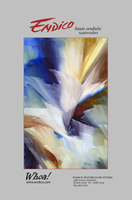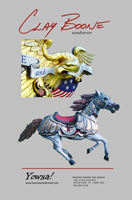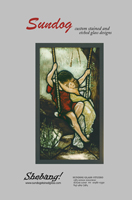|
Oh, these small people and
their little magazines.
- Charles Mannino
Truth is an absolute defense.
- American Road Cycling legal team
Before reading further check out:
SEARCH
GOOGLE and SEARCH MSN
SlingShot has gone and done it
again.
As an ironic and astounding follow-up to SlingShot's
renowned censoring by the
Local Taliban, he has once again been censored.
This time not
for his words, but for images.
You are going to be dumbfounded and
amazed by this.
Or maybe not.
Can you guess why?
 

Above are the three paid ads that were censored by
The Hudson River Museum & Gallery Guide
Can you guess why?
In December of 2005, SlingShot
created a series of three full-page Sugar Loaf, NY ads (shown above)
prepared for a contracted agreement
with The Hudson River Museum & Gallery Guide.
The ads were scheduled to run on
pages 3, 5, and 7 of the little art magazine's 2006 Spring edition.
However, soon after the final
artwork was delivered, the magazine backed out of the
agreement and refused to publish the ads as previously agreed.
An agent of the periodical went so
far as to try and control the content of the
paid for ads.
When the actual reason for the denial
was finally understood, SlingShot was left aghast—realizing that it was due to a cultural bias and bigotry
as the magazine attempted to first alter then finally censor the
content of the ads.
Turns out it was because of what was deemed to be
a "politically incorrect" element on one of the pages.
Can you guess which ad above was the
offending one?
Maybe it will help you decide if you click on the images for a
closer look.
You will need all the help you can get to see where the
problem lies.
SlingShot was not so surprised, because he
had anticipated a
problem... just like he had expected there might be a problem before publication of
the now famous Spin Bitch article.
But there are many things of greater importance than political correctness.
Thus Bob saw the potential problem but still incorporated the image into the ad.
He deemed it was a necessary
illustration of the artist's work.
After all, the work is robustly
unique and richly deserving of attention, and this particular piece
required proud display in hopes of bringing widespread
understanding of its worth, regardless of possible inflammatory content.
Following is a story of horrid
political intrigue, of social and cultural censorship, and of the
fruitless snobbery of a wannabe magazine cobbled together by
wannabe artists.
Cultural Bigots
Before you even think about advertising
in this tiny art rag, be sure to read on!
The Idea
The idea for the triple-page ad was simple.
It was to fill the first three full right side pages at the front
of the magazine, and it
was to show the work of three separate Sugar Loaf artisans.
Plus the ad copy was to be as simple as possible in order to allow the images to speak for
themselves.
You will notice on the reprints of the images above, the pages each
contained but a single word of advertising copy.
Only one large exclamation (bottom left of each image) which read
in order:
Woah! Yowsa!
Shebang!
Actually even those few words were not needed, but they did
provide a startling repeat of just what would have already
appeared in any viewer's mind.
The images were striking and
true to each artist's work.
Website addresses were placed below each
exclamation leading to more information about each artisan's work
online.
The money was in place, and everything was all set up and ready to run: then came the trouble.
The Problem
One similar page had already run for Endico, and the ads were to be the first in a series of
other like minded ads.
SlingShot had long since become sick and tired of seeing the local
Sugar Loaf artistic community perpetually misrepresented by a steady
stream of wannabe startup businesses who (over the past 30
years previous) had wandered into town, taken over the advertising,
failed in their businesses, and left the true artisans in the Hamlet to endure
the misunderstanding that they left behind.
When Bob saw the first issue of the Hudson River
Museum & Gallery Guide, he knew two things.
First, the magazine had good enough print quality with an appropriate format
for advertising the arts.
Second, the true core artisan businesses which had made Sugar
Loaf, NY a special destination (known throughout the world), were
most likely going to be missed once again in the uninformed promotional
wrangling of (soon to be gone) new comers.
Moreover, Bob was very much aware of the long standing problem with local media and tourism groups, who uniformly maintained a general lack of
understanding about why Sugar Loaf was truly singular, and why the
artisans flourished despite a virtual black-out by the very groups who
were supposed to be pointing out their specialties.
The Answer
SlingShot decided to take it upon himself to put
together a series of ads that went to the heart of the matter, and he offered to pay for their placement
himself.
In that way he could put his full focus on making the best ads possible,
still under the intense direction of the artists involved, but
without the burden of cost based decisions and discussions as to
whether or not this advertising venue would be worth it.
His own feeling was that it probably would not be worth much to
the community, but at least there would be a clear articulation of
what that community is...
finally.
He spent two weeks running draft copies of the three ads back and
forth to each artist, so they did not even have to leave
their studios in order to enjoy the benefits of this advertising
campaign.
As it turned out, he was not going to have to pay for all
of it, because the results were eliciting such excitement that those
involved had offered to pay their own way.
The Process
In summary, the ads were assembled using 150 years of total arts, graphics, and cultural
experience (a half dozen 30-year plus professional artists working together) combined
efforts to place these ads stratospherically above any
of the other ads that would be running in the same Hudson River
Museum & Gallery Guide issues.
Needless to say, SlingShot was very proud to submit the final
artwork to the magazine, "Job well done, time to get ready for
this winter's cycling in Florida."
The Censorship
It was only a few days later that
Mary Endico (who was
handling phone call discussions with the magazine) got the
ominous call.
She had previously had all her dealings with Hudson River
Museum & Gallery Guide's Editor/Publisher - Douglas Alderfor.
But this call came from
Managing Editor - Peter Occhiogrosso.
Apparently, there was a problem with the ad placement.
Mary was told that somebody had made a
mistake, and the ads could not run on consecutive pages as per the
contract.
There was another advertiser who would need
to be placed in between the three purchased pages.
SlingShot was passing by Mary's desk as this unfolded, so
it became a conference call, and SlingShot said
merely, "No problem, we'll just put it off till next issue."
Bob knew right away, but Mary was still unaware that a major contractual agreement had been
broken (and this meant trouble), so she asked, "Well, what if we
bump all three pages back a page?"
Peter Occhiogrosso replied (in a tone unbecoming a
service rep), "Well that might work.
But there is also a problem with one of the pages."
There ensued a lengthy lecture about composition, about the need to
adequately represent the artist's work, and about the need to make the pages uniform in
appearance.
It seems Peter Occhiogrosso had assumed the ad
series was being put together by a standard "paste up business"
(an ads for hire business with no actual input into the final outcome)
who would be paid a small fee by
the artists.
Of course there would be the usual kick-back from the publication
itself—under the guise of, "design artists' rates."
So if things didn't go well, somebody would be over a barrel
when the ads didn't run.
Peter Occhiogrosso was probably used to
being in that particular cat bird's seat.
Peter had not a clue that these ads
had been put together by
somebody actually involved with one of the businesses (an artist
himself), and that they were doing the work
gratis, and how despite that they had already spent two weeks making sure each
artist was over-the-top happy with their ad.
Unfortunately for Peter Occhiogrosso, this was not just
another standard opportunity to make an insecure "ad agency" cave
in to
an obviously superior "studied artistic aesthetic."
Had the World not Changed
Peter had also missed the fact that the world was changed.
The
Internet already allowed for publication of unique information on a scale that
his little art magazine was never going to be able to match.
In this
case, it was
SlingShot who enjoyed total control of the product, because on the web
Bob happens to
know something about how to make things happen.
His skills (though not immediately obvious) far
outweighed Peter's old timey facility at merely kicking around insecure artist wannabes
(not to mention the smattering of a wish to be gallery or two).
This was a lesson our little art rag would have to learn over time.
Sugar Loaf did not need their magazine, nor did Bob (certainly), but he merely
hoped see the truth about the state of the arts in Sugar Loaf accurately portrayed in print just one time before he died.
Finally, this Peter guy made his fatal error.
He said, "Well, if
you would just take the American Eagle out of the ad, it will be
fine."
"WHAT?!" shouted Bob as he turned toward
the door.
Occhiogrosso fumbled, "Well, the magazine has a policy of not
publishing commercial work such as signs. And of course no crafts at
all. Only art."
That pretty much clinched it for SlingShot.
He yelled to Mary as he left the room, "Hang up the phone. You are not advertising in
that fucking magazine. Cancel the contract."
SlingShot did not even hang around to hear it explained to
Peter that there were in fact numerous crafts already advertised in their
current issue—with those pages pointed out to him.
There was even an ad with Mickey
Mouse in it, which probably says more about The
Hudson River Museum and Gallery Guide than anything else stated
here.
SlingShot also did not stay to hear it
pointed out that the American Eagle (which was so obviously
inappropriately displayed) was not a sign at all, but was a wall
hanging, as in the likes of a Monet, Degas, Van Gough, Da Vinci,
etc.
He didn't even get to hear it pointed out to Peter that
this American Eagle was not just a block of wood purchased at a crafters'
retail store and "painted up pretty," but it was an actual wood
sculpture
covered in true Gold Leaf.
I was not mentioned to Peter, but his red-herring problem with
the composition of the Eagle actually pointed to a clever use of foreshortening (a design concept, developed and refined by the Renaissance Masters),
and it was purposely used in this ad to good effect as the perfect
solution for a problematic
compositional necessity.
However, it was mentioned to Peter that the "not placing the images in a square
to match the other ads," was specifically requested by the
wood sculpting artist himself, because he, "didn't want this to look like a
typical advertisement," (as apposed to it not likely to be
accepted by him), though it was not explained that this
wish came from somebody who was a second generation artisan who had polished their aesthetic
by receiving a college level art degree then refining it over 30
years working as a professional in the field!
SlingShot did not have to stay by the phone to hear all of
this, because he had immediately understood that it was a forgone
conclusion that it was going to be the all of us (artisans) who just did
not know how to design stuff.
And, of course, the
image of the American Eagle itself had nothing to do with it.
Yeah, right.
Degreed Warrior
So now SlingShot had earned his censorship wings.
Previously the
Religious Right tried to take him out over the
Spin Bitch
episode.
Now Liberal Left Wing
Extremists had taken their shot.
Guess what guys? The Internet is out of the bag. SlingShot
was phased not at all.
The Solution
Just wait till one of these guys finally gets a computer and does
an Internet search for their own name or the magazine's.
The world is changing on these
sorts of aggravating assholes from New York City, accustomed to being
able to intimidate "artists" using snobbery alone.
The Editor/Publisher - Douglas Alderfor, didn't even
know what a TIFF file is.
Just wait till one of these guys finally gets a computer and
learns how to: SEARCH
GOOGLE and SEARCH MSN, for "The Hudson River
Museum & Gallery Guide."
They might actually start treating "artists" with a little more
respect after that.
But of course it will be too late
for them. Too bad. What a loss.
Post Script Elaboration
As of December of 2005, the Hudson River
Museum & Gallery Guide is a startup periodical, so you might be
searching for information about it using a number of names in order
to decide about your own advertising budget.
Several possible search criteria are provided
below, so Internet search engine robots can gather
information about this page that you are reading.
The chief owner/operators/principals of that mag from whom the
cultural bigotry, censorship, and inept handling of a client
were unerringly exhibited, and described above are:
Editor/Publisher - Douglas Alderfor
Managing Editor - Peter Occhiogrosso
Some of the other principals who must also bear
responsibility due to their involvement in the publication are:
Art Director - Diana Rose
Advertising/Sales - Paula Darlington
You may wish to
contact the Hudson River Museum & Gallery Guide to
question them directly.
Be
aware they are not in the least bit web savvy, so they might not even
bother to answer you.
The Publisher himself does not even
know what a TIFF file is.
In any case, here is the e-mail address:
info@hudsonriverguide.com
[01/16/11: The inevitable demise of this mag came some
time ago.]
Plus, their web site (if you choose
to call it such) is at:
www.hudsonriverguide.com
[01/16/11: This link also went down
with the mag.]
You definitely
will not find
ENDICO WATERCOLORS listed there, Mary
requested her name be removed from the site, and cancelled her
advertising contract due to their obvious bigotry along with the censorship they
perpetrated.
In any case, you might want to think
long and hard about wasting your money advertising in the Hudson
River Museum & Gallery Guide.
Supporting such drivel will
not help your business, plus doing so will be ill advised for the
health of your soul as well.
In the meantime: web bots, have at
this page.
The world it is a changin'. It probably wouldn't hurt the
search engine returns any to add the Hudson River
Museum & Gallery Guide one more time to this page. Got questions about, or problems
with, the
Hudson River Museum & Gallery Guide?
The Hudson River Museum & Gallery Guide
Hudson River Museum & Gallery Guide
Hudson River Museum and Gallery Guide
Hudson River Museum Guide
Hudson River Gallery Guide
Hudson River Guide
Hudson River Museums
Hudson River Galleries
Hudson River Art
Hudson River Guide
Hudson River Guides
Problems with Hudson River Museum & Gallery Guide
Problems with Hudson River Museum and Gallery Guide
Problems with Hudson River Museum Guide
Problems with Hudson River Gallery Guide
Problems with Hudson River Guide
Problems with Hudson River Museums
Problems with Hudson River Galleries
Problems with Hudson River Art
Problems with Hudson River Guide
Problems with Hudson River Guides
You may have been
looking for this page using any one the following search strings.
Postscript: 01/18/11 - possibly you are aware, the Sugar
Loaf artists mentioned above remain (again), while another piece of
crap magazine is gone (again).
|